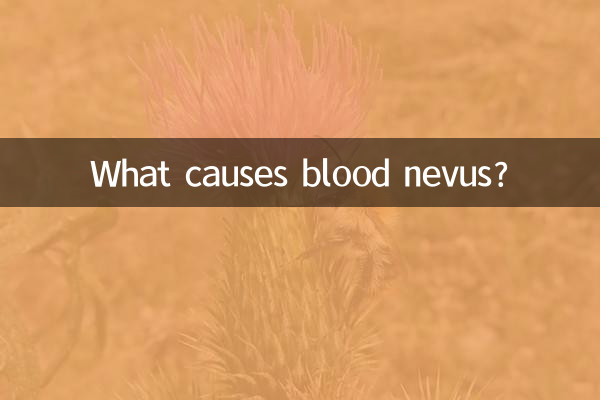What causes blood nevus?
Hemorrhagic nevus is a common skin problem that usually appears as small red or purple spots on the face, neck or trunk. In recent years, the causes and treatments of blood moles have become a hot topic. This article will combine the hot content on the Internet in the past 10 days to provide you with a detailed analysis of the causes, symptoms and countermeasures of blood moles.
1. Common causes of blood moles

The formation of blood nevus is related to many factors. The following are the most discussed reasons on the Internet in the past 10 days:
| Type of cause | Detailed description | Related discussions |
|---|---|---|
| telangiectasia | Abnormal dilation of capillaries on the surface of the skin leading to accumulation of blood | high |
| Hormone changes | Hormone fluctuations caused by pregnancy, puberty or endocrine disorders | middle |
| abnormal liver function | Traditional Chinese medicine believes that blood moles are related to the decline in liver detoxification function | high |
| genetic factors | People with a family history of blood nevus are more likely to develop it | Low |
| environmental stimulation | External stimulation such as ultraviolet radiation and exposure to chemicals | middle |
2. Typical symptoms of blood nevus
According to recent clinical data from medical institutions, hemorrhagic nevus usually exhibits the following characteristics:
| Symptom characteristics | frequency of occurrence | Things to note |
|---|---|---|
| red or purple dots | More than 95% | Size is usually 1-5mm |
| Painless and itchy | 90% | If pain occurs, seek medical attention promptly |
| Commonly found on face and neck | 85% | May be related to UV exposure |
| Increases with age | 70% | More common in people over 40 years old |
3. Recent popular treatment options
In the past 10 days, the following treatment methods have been the most discussed on social platforms and medical forums:
| Treatment | efficient | recovery cycle | Popularity |
|---|---|---|---|
| laser treatment | 90-95% | 1-2 weeks | extremely high |
| Cryotherapy | 85-90% | 2-3 weeks | high |
| Chinese medicine conditioning | 60-70% | 1-3 months | middle |
| minimally invasive surgery | More than 95% | 1-2 weeks | middle |
4. Lifestyle suggestions for preventing blood moles
According to recent health science content, you need to pay attention to the following points to prevent blood moles:
1.sun protection: Ultraviolet rays are an important factor that causes capillary dilation. You should use sunscreen with SPF30 or above when going out.
2.Liver care: Reduce alcohol intake, maintain a regular schedule, and eat liver-protecting foods such as wolfberry, chrysanthemum, etc. appropriately.
3.skin care: Avoid using irritating cosmetics and choose mild skin care products.
4.diet conditioning: Eat more foods rich in vitamin C and K, such as citrus fruits, green leafy vegetables, etc.
5.Regular inspection: People over 40 years old are recommended to have skin examinations every year to detect abnormalities in time.
5. The 5 issues that netizens are most concerned about recently
1. Can blood moles become cancerous?
Recently, medical experts said that the probability of common blood moles becoming cancerous is extremely low, but if they appear to grow rapidly, bleed, etc., they require prompt medical treatment.
2. Can blood moles disappear on their own?
Most blood moles will not go away on their own, but can be effectively removed with appropriate treatment.
3. Will there be scars after treatment?
Modern laser technology basically leaves no obvious scars after treatment, but post-operative care is required.
4. What is the difference between blood nevus and spider nevus?
Blood nevus is dot-shaped, while spider nevus is radial. The causes are also different.
5. What should I do if blood moles appear during pregnancy?
Bloody moles during pregnancy are mostly related to hormonal changes and usually improve after delivery. It is recommended to consult a professional doctor.
From the above analysis, we can see that although blood moles are common, their causes are complex. Recently, there has been a particularly heated discussion on the relationship between liver function and blood nevus based on the integration of traditional Chinese and Western medicine. If you find abnormal blood moles on your body, it is recommended to consult a dermatologist promptly to obtain a professional diagnosis and treatment plan.

check the details

check the details